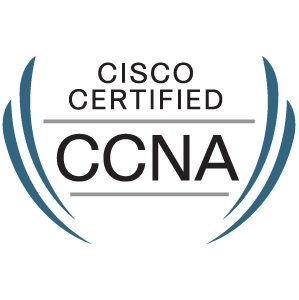
What is CCNA ?
Cisco Certified Network Associate
It is one of the most valued IT certification program
CCNA is for whom?
Whether you are after your O/Levels or A/Levels or whether you are employed or unemployed or having IT knowledge or not, you do not have to worry…
It is only a matter of your interest and motivation to make your dream career come true.
CCNA is not only making you qualified to join a better position in an organization within a very short period of time, it will also build your career path to grow up for more higher positions in your career within 03 years, if you are interested in studying more. That is the reason CCNP and CCIE courses are also introduced for your benefit at a very low cost comparing to all other courses.
You have done CCNA means your career path is sustained, after completing CCNA all you have to do is maintain your career growth by continuing your studies in Cisco. You are not required to follow any other courses.
Passing the CCNA test indicates knowledge of networking for small to big enterprises. It confirms the ability to manage a network of 100 routers, which means about 1,000 switches, which also means about 25,000 users. Cisco calls this as a small network.
As the courses are filled with lot of practical lessons becoming an expert on the trade is no more a challenge for you…
Network Fundamentals
- Compare and contrast OSI and TCP/IP models
- Compare and contrast TCP and UDP protocols
- Describe the impact of infrastructure components in an enterprise network
- Describe the effects of cloud resources on enterprise network architecture
- Compare and contrast collapsed core and three-tier architectures
- Compare and contrast network topologies
- Select the appropriate cabling type based on implementation requirements
- Apply troubleshooting methodologies to resolve problems
- Configure, verify, and troubleshoot IPv4 addressing and subnetting
- Compare and contrast IPv4 address types
- Describe the need for private IPv4 addressing
- Configure, verify, and troubleshoot IPv6 addressing
- Configure and verify IPv6 Stateless Address Auto Configuration
- Compare and contrast IPv6 address types
LAN Switching Technologies
- Describe and verify switching concepts
- Interpret Ethernet frame format
- Troubleshoot interface and cable issues (collisions, errors, duplex, speed)
- Configure, verify, and troubleshoot VLANs (normal/extended range) spanning multiple
switches - Configure, verify, and troubleshoot interswitch connectivity
- Configure, verify, and troubleshoot STP protocols
- Configure, verify and troubleshoot STP related optional features
- Configure and verify Layer 2 protocols
- Configure, verify, and troubleshoot (Layer 2/Layer 3) EtherChannel
- Describe the benefits of switch stacking and chassis aggregation
Routing Technologies
- Describe the routing concepts
- Interpret the components of a routing table
- Describe how a routing table is populated by different routing information sources
- Configure, verify, and troubleshoot inter-VLAN routing
- Compare and contrast static routing and dynamic routing
- Compare and contrast distance vector and link state routing protocols
- Compare and contrast interior and exterior routing protocols
- Configure, verify, and troubleshoot IPv4 and IPv6 static routing
- Configure, verify, and troubleshoot single area and multi-area OSPFv2 for IPv4
(excluding authentication, filtering, manual summarization, redistribution, stub, virtuallink,
and LSAs) - Configure, verify, and troubleshoot single area and multi-area OSPFv3 for IPv6
(excluding authentication, filtering, manual summarization, redistribution, stub, virtuallink,
and LSAs) - Configure, verify, and troubleshoot EIGRP for IPv4 (excluding authentication, filtering,
manual summarization, redistribution, stub) - Configure, verify, and troubleshoot EIGRP for IPv6 (excluding authentication, filtering,
manual summarization, redistribution, stub) - Configure, verify, and troubleshoot RIPv2 for IPv4 (excluding authentication, filtering,
manual summarization, redistribution) - Troubleshoot basic Layer 3 end-to-end connectivity issues
WAN Technologies
- Configure and verify PPP and MLPPP on WAN interfaces using local authentication
- Configure, verify, and troubleshoot PPPoE client-side interfaces using local
authentication - Configure, verify, and troubleshoot GRE tunnel connectivity
- Describe WAN topology options
- Describe WAN access connectivity options
- Configure and verify single-homed branch connectivity using eBGP IPv4 (limited to
peering and route advertisement using Network command only) - Describe basic QoS concepts
